I just noticed the date on my last blog ... yikes, it was almost 6 months ago. I can't believe I've haven't posted in 6 months! But I suppose it is an example of how obligations and commitments to important projects can get completely out-of-hand and impact the bird watching lifestyle I prefer. Lately I've been paying attention to that "empty" feeling I've noticed lately. It finally dawned on me as I trudged along taking care of pressing projects that I was feeling out-of-sorts because I haven't been spending any time enjoying what I love most in life ... birds and the natural world. So, even though my projects are still needing my attention I'm going to find the time to enjoy my passion and post to my blog, too.
To be truthful, I've haven't even been a devoted backyard bird feeder lately ... and it really hurts to admit that. There has just been too much to do and so I couldn't keep the bird feeders cleaned and filled. I guess the only feathered friends that could really count on me this past summer were the hummingbirds that are here year-round. I did manage to keep them happy. I know that the birds don't rely on getting all they need from bird feeders and that helps me feel slightly better. But honestly, my guilt level is pretty high at the moment. So I hauled all the feeders out of storage and they are being rehung. Unfortunately, I'm not getting them up fast enough to participate in the Cornell Lab of Ornithology Project Feeder Watch ... their annual wintertime wild bird feeding project. So I'll just have to be content with my intention to register for it next winter.
Even without the bird feeders we had feathered visitors all year. That is typical here in the San Diego area. BTW, I encourage you to visit San Diego if you like to bird watch beyond your own locality. You won't be disappointed.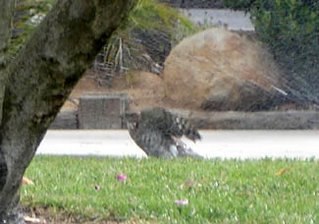 One special experience this past spring was during an extremely hot period. We had a broken sprinkler and after it was fixed the system was turned on to make sure everything was working okay. Shortly after the sprinklers came on an adult male Cooper's Hawk swooped down into the spray and had himself a good soak ... flapping wings as he jumped and danced in the spray. I ran for my camera and warily made my way back as close as I could to the hawk. Surprisingly when I got back with the camera another hawk (that I assume was his mate since a pair of Cooper's had been nesting nearby) had joined him and they were both having a great time in the cool water. I was transfixed watching the amazing display and by the time I got ready to take a picture I discovered the camera batteries were dead. So I quietly retreated to the house for another camera and loaded new batteries to be safe. By the time I returned to my hiding place the active bathing was over and the female had flown to a nearby palm tree. I tried to get a good shot of the male who, by now, was just standing in the spray. I snapped a couple of shots and then he flew away to join his mate. Before I turned around to leave another hawk flew down to get his share of the cool water. Again I took pictures, but they were disappointing, too (as you can see by the photo above). However, it does show an immature Cooper's Hawk. My guess is that this youngster was this year's offspring of the pair bathing earlier.
One special experience this past spring was during an extremely hot period. We had a broken sprinkler and after it was fixed the system was turned on to make sure everything was working okay. Shortly after the sprinklers came on an adult male Cooper's Hawk swooped down into the spray and had himself a good soak ... flapping wings as he jumped and danced in the spray. I ran for my camera and warily made my way back as close as I could to the hawk. Surprisingly when I got back with the camera another hawk (that I assume was his mate since a pair of Cooper's had been nesting nearby) had joined him and they were both having a great time in the cool water. I was transfixed watching the amazing display and by the time I got ready to take a picture I discovered the camera batteries were dead. So I quietly retreated to the house for another camera and loaded new batteries to be safe. By the time I returned to my hiding place the active bathing was over and the female had flown to a nearby palm tree. I tried to get a good shot of the male who, by now, was just standing in the spray. I snapped a couple of shots and then he flew away to join his mate. Before I turned around to leave another hawk flew down to get his share of the cool water. Again I took pictures, but they were disappointing, too (as you can see by the photo above). However, it does show an immature Cooper's Hawk. My guess is that this youngster was this year's offspring of the pair bathing earlier.
Shortly after the hawk experience a close relative (and bird watching buddy) had emergency health problems which led to very serious surgery. Helping him recover ... and those projects I mentioned meant no more bird watching for me ... until now. I'm thrilled to be back!
Look for links to some wildlife cams in my next post.
Learn more about bird watching and backyard bird feeding.
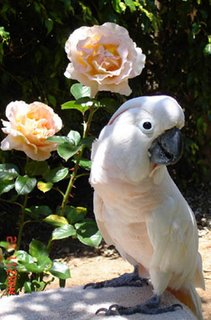 I've been in a 22 year love affair. Yep, I sure have. Who has captured my heart? Well, I'll give you a hint . . . he is wrapped in a bundle of the most beautiful feathers anyone can imagine. These feathers are soft, fluffy at times, and absolutely take your breath away. Are you familiar with the rose bush named "Peace". If you are then you know the color tones of my beautiful friend. If you don't, take a look at the photo. It's my beloved Fagan, a Moluccan Cockatoo posing with the "Peace" rose in my backyard.
I've been in a 22 year love affair. Yep, I sure have. Who has captured my heart? Well, I'll give you a hint . . . he is wrapped in a bundle of the most beautiful feathers anyone can imagine. These feathers are soft, fluffy at times, and absolutely take your breath away. Are you familiar with the rose bush named "Peace". If you are then you know the color tones of my beautiful friend. If you don't, take a look at the photo. It's my beloved Fagan, a Moluccan Cockatoo posing with the "Peace" rose in my backyard.
I couldn't resist putting the two of them together and taking the picture to share. Although I have to admit my photographic abililty is not improving much because Fagan's beautiful peach-colored feathers look a bit washed out. What you see is the best I could do.
Fagan and I have been together since he was most likely 6-8 months old. Why the estimated age? Because he was captured in the wilds of Indonesia as a baby bird. The only thing about our relationship that saddens me is that he couldn't fulfill his destiny as he was intended. Back in the mid-80's the U.S. still allowed importation of wild caught birds. I was a novice and didn't realize the horrors the wild bird trade committed. So I happily supported the trade when I saw this absolutely gorgeous, sweet baby bird in my local bird store. It was love at first sight. It was later that I came to regret my participation in furthering the business of trapping of wild birds by purchasing him. But other than that, I have no regrets . . . not for myself, at least.
Living with Fagan has been wonderful. Getting to know him has been a fascinating adventure. But it hasn't been without challenges, frustrations and hard work. But even with that I'm so grateful to have had the experience and lessons he has taught me. I wish I could repay him somehow. But I can't -- I can't provide the natural life he should have had. All I can do is make the best life possible for him. Since he has thrived over the years, I suppose I've succeeded somewhat. He knows no other life and is content. He has someone who loves him and an Umbrella Cockatoo buddy. Owing to the fact that he is incredibly intelligent and extremely adaptable creature I think I can honestly say he is happy. For that I am very grateful.
One day last week I was in my backyard working madly away in a flower bed. It was in need of some general cleanup and removing dead growth left patches of bare ground. In the process of clearing away the vegetation I noticed a couple of caterpillars. Being the nature lover I am, I replaced them in the vegetation and went on with my work. After a time, our frequently visiting Western Scrub Jay appeared in the birch tree above me. She (at least I think it's a she) sat above me and seemed to be watching me work. Shortly, I discovered it wasn't me that she was interested in, but rather she'd spied one of the caterpillars who had crawled back out of the flowers. The jay patiently waited until I was ready to haul away the debris I'd accumulated. As soon as I was about 15 feet away the Jay swooped down and picked up the caterpillar. So much for my trying to "protect" the caterpillar!
Now here's the thing I'm confused about. The Jay didn't eat the caterpillar, but instead flew off with it. Now, that is certainly their habit with peanuts. They hide peanuts for later eating. But you can't cache a caterpillar so I assumed the Jay would have eaten the insect after catching it. But no, she definitely was taking it somewhere.
So, being springtime, I assume that her purpose of flying off with the caterpillar was to bring "baby food" to her nest. Seems reasonable. But then I wondered if this might be an immature Jay with the caching instinct even for bugs. I guess I really have to cast my vote for the "baby food" theory.
This Jay has done another interesting thing. It has developed a taste for the grape jelly we offer the orioles. Up until recently the Jay has come to the feeder and eaten the jelly. Now recently, I've witnessed her flying off with gobs of jelly in her beak. Is the caching instinct at work again? Or, is she taking grape jelly to feed young ones? Yikes, I hope not ... that doesn't sound like a good diet for growing nestlings. There is a little more protein in a caterpillar than grape jelly! Maybe I'd better go back out to the garden and dig around some more.
 One of the great joys in my life are my Lesser Jardine Parrots. They are the smallest parrots I have and occupy a place in my heart that none of my other avian kids can fill.
One of the great joys in my life are my Lesser Jardine Parrots. They are the smallest parrots I have and occupy a place in my heart that none of my other avian kids can fill.
Jardines are known as the "African Amazon" alluding to the fact that they are very Amazon-like in personality and a little bit in appearance. Lesser Jardines are smallish-size parrots ... about 11 inches long. My Jardines are clowns. They have a funny little lilt to their walk, love to bounce around, roll on their backs, hang by one foot. Perhaps you're getting a visual picture. Adding "cute as a bug" will sum them up to a tee. They are also my best talkers . . . really they are quite gifted. They are also beautiful -- their feathers are the most amazing green color combined with black, with some of the green feathers being quite irridescent. As they get older red feathers appear usually on the head, edges of wings and also underneath the wings. The posed photo of Harry and Isabel depicts their color as well as a photo can. However, their colors are really more vibrant. 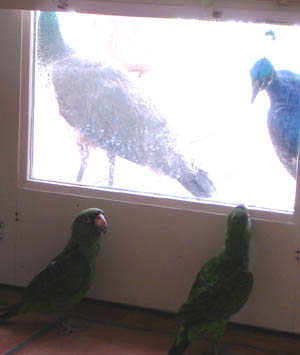 This photo shows two Jardine babies attracted to the window inspecting our visiting peacocks, which were just as curious about them. When I discovered this encounter I didn't have my camera close by, so missed the cutest photo-op. The Jardines were busy jumping up and down trying to get a better look. The peacock was showing just as much interest, but without the body language. Of course, I ran to get my camera and by the time I got back the peacocks had left the window. I waited for them to return while sitting scrunched up in the corner. It took long enough for my back to start hurting. As soon as they returned I tried to get a photo and all I managed to do was to startle the Jardines, who then turned into little statues when the flash went off. Oh, the trials bird photographers must go through. I hung in there as long as I could and finally got this shot, which is poor at best. Trying to deal with inside lighting vs. outside lighting is well beyond my capability. I had to lighten the photo enough to see the Jardines and the photo color ended up being washed out. Oh well, perhaps with more experience I'll learn how to deal with photographic challenges like this. I'll also need to take more photos of the Jardines so they get accustomed to the flash going off.
This photo shows two Jardine babies attracted to the window inspecting our visiting peacocks, which were just as curious about them. When I discovered this encounter I didn't have my camera close by, so missed the cutest photo-op. The Jardines were busy jumping up and down trying to get a better look. The peacock was showing just as much interest, but without the body language. Of course, I ran to get my camera and by the time I got back the peacocks had left the window. I waited for them to return while sitting scrunched up in the corner. It took long enough for my back to start hurting. As soon as they returned I tried to get a photo and all I managed to do was to startle the Jardines, who then turned into little statues when the flash went off. Oh, the trials bird photographers must go through. I hung in there as long as I could and finally got this shot, which is poor at best. Trying to deal with inside lighting vs. outside lighting is well beyond my capability. I had to lighten the photo enough to see the Jardines and the photo color ended up being washed out. Oh well, perhaps with more experience I'll learn how to deal with photographic challenges like this. I'll also need to take more photos of the Jardines so they get accustomed to the flash going off.
 As I've mentioned before, we have several peacocks in our neighborhood. They are free to roam about and often spend time at our home. The dominant male loves to see his reflection in the hubcab of my SUV.
As I've mentioned before, we have several peacocks in our neighborhood. They are free to roam about and often spend time at our home. The dominant male loves to see his reflection in the hubcab of my SUV.
Looking out a window this morning I saw him admiring himself and I tried to get a photograph. My only problem is this guy is a little people-shy. I'm not sure why he is so nervous . . . more so than his extended family members who often nap on our deck.
It's nearly impossible to sneak up close enough to him to get a good photo. I missed him as he admired himself in the hubcap mirror. And I just barely missed capturing this photo as he headed for cover. The palm frond obscured his head a little, but I managed to get this mediocre shot of his beautiful tail. Perhaps the next time he visits I'll have better luck.
 While out on my bird walk last Tuesday morning I was overwhelmed by all the singing and carrying on by the birds as I walked down the road. It was definitely a sign that spring has arrived. The male birds were in great form singing, each trying their best to attract a partner for the season. The music was wonderful, but I wasn't able to identify which birds were making what sounds unless I was able to see the bird.
While out on my bird walk last Tuesday morning I was overwhelmed by all the singing and carrying on by the birds as I walked down the road. It was definitely a sign that spring has arrived. The male birds were in great form singing, each trying their best to attract a partner for the season. The music was wonderful, but I wasn't able to identify which birds were making what sounds unless I was able to see the bird.
If there is ever a time of year to know how to identify bird songs it is at the height of breeding season. So our local Nature Center sponsored a class on Birding By Ear in San Diego County. I decided to attend the class and see what birding by ear is all about.
I dragged myself out of bed very early after getting to bed at 1:30 a.m. Whew! Being very tired is not the way to begin the day, especially when you are going to sit in a darkened room watching slides and listening to the songs and calls of over 135 birds. I had to struggle some to stay alert, but I managed to get the gist of it. But the bottom line is the skill in identifying birds comes with a boat load of practice and then some more practice.
But you need to know how to put that "practice" to work. Here is an overview.
Repetition (that's the practice I mentioned . . . the need to listen to the bird song repeatedly until it begins to remain in your memory.)
Then there's What To Listen For
- Pitch ( is the bird song low, high, somewhere in-between, ascending, descending, or both)
- Timbre or tone quality (clear, harsh, buzzy, nasal)
- Rhythm (single note, accelerating, repetitive, rambling, unique rhythm)
How to Remember
- Describe in your own words
- Picture
- Make a musical notation (I guess this would be for music majors . . . that isn't me!)
- Pneumonic (i.e. a Yellow Warbler's pneumonic is "sweet, sweet, sweeter than sweet")
- Compare to similar sounding birds
Things To Be Aware Of
- Mimicry talents of some species (Mockingbirds/Thrashers, Starlings, Lesser Goldfinches, Steller's Jay)
- Distance/ambient noise
- Habitat
Field Experience
- Listening to the songs and calls of birds in the field is a must-do. And you have to do a lot of it.
The second half of our class will be held next Saturday when we go into the field for first-hand experience. So you can be sure I'll be doing my homework.
We received a CD of recorded bird calls at the class. The CD was created by Frank T. Awbrey, Professor Emeritus, San Diego State University. Sadly Prof. Awbrey passed away in 1998. He was actively pursuing research in bioacoustics (studying the sounds made by animals) until shortly before his death. It is a privilege to receive this tribute in honor of some of his work and I know it will help me on my quest to identify birds by their songs and calls.
It's great to have Prof. Awbrey's CD and it will help me get started. But there are also a number of other recordings and tools available to help learn bird songs. Some that our instructor suggested are the Birding By Ear CD's, among many other choices. As far as tools go, the Identiflyer is available to help identify birds with their songs while in the field. Also, along that line is a new tools offered by BirdPod consisting of programs that can be loaded into an IPod.
CD's, among many other choices. As far as tools go, the Identiflyer is available to help identify birds with their songs while in the field. Also, along that line is a new tools offered by BirdPod consisting of programs that can be loaded into an IPod.
Looks like my "I-want" list will continue to grow. As I continue on my quest to identify birds I'm discovering I like all the gadgets and technology. They are cool and really help. My interest in birds over the past 21 years has directed me down an interesting path -- at the very least it has been one filled with self-growth. Well, I guess getting a little wiser with age has helped, too. Yep, that could be. And if that's it, then getting older really isn't so bad.
I remain frustrated with my inability to go to Lake Henshaw for a personal look at the Bald Eagle chick. The last update I mentioned about the progress at the nest was on March 25th. You'd think between then and now I could find the time to drive to the lake. But, nope . . . it hasn't been in the cards for me. The reason? My stepdad, who is the guy that is helping me set up a digiscope to photograph the nest activity found himself unexpectedly in the hospital. That visit led to open heart surgery on March 10th. Needless to say, his needs have been at the top of my agenda . . . especially since he came home on April 1st. Hospital visits and nursing care have take up much of my time. Besides I couldn't go up to visit the nest without him, and he isn't quite ready to travel. But I expect that he'll be able to go along with me in the next week or so.
In the meantime, I receive emails about observations of the nest that other birders have had. But I kind of dropped the ball, since the last report I read was back on April 9th. So better late than never -- here is that observation:
" . . . watched the Bald Eagle chick at Lake Henshaw being fed a large fish (at least 16 inches long) this a.m. The adult fed the young and removed the fish carcass within 3/4 hr. It then brought grass into the nest."
I hope by the time I'm able to view the nest I'll see something at least as interesting. If good fortune smiles on me maybe I'll return with a photo or two to share.
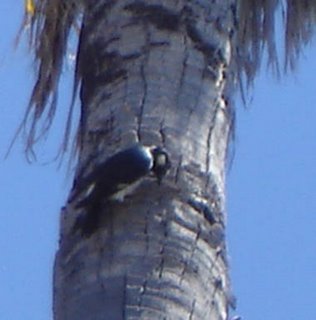 I've been giving my new birding binoculars a workout. I've been going on the field trips associated with my birding class every weekend. And I've returned to my morning walks for exercise. But now those walks are all about sighting and identifying birds. What fun! While I have to admit that constantly interrupting power-walking to see a bird isn't the best way to get a cardio-vascular workout, I am walking farther and climbing higher hills. I hope that makes up for the frequent stops.
I've been giving my new birding binoculars a workout. I've been going on the field trips associated with my birding class every weekend. And I've returned to my morning walks for exercise. But now those walks are all about sighting and identifying birds. What fun! While I have to admit that constantly interrupting power-walking to see a bird isn't the best way to get a cardio-vascular workout, I am walking farther and climbing higher hills. I hope that makes up for the frequent stops.
I'm also taking my digital camera along on my morning walks. I've been wanting to photograph birds for sometime now. It's good to have a photo (even if it is poor) to help remember the bird I want to identify. My goal is to become a good photographer. As you can see from the photos I took today, I have a long way to go. The photos, by the way, are of Acorn Woodpeckers (Melanerpes formicivorus) in case you can't tell. I was so excited when I saw these birds for several reasons. First, they are striking to look at . . . sorry my photos don't show how beautiful they are. And yes, they do have red "caps" on their heads. And their behavior is just as appealing as their bright little black and white suits. As you can see the single bird in the photograph (above) was in the company of two others (left). Time slipped by quickly as I watched these gregarious, social birds.
The photos, by the way, are of Acorn Woodpeckers (Melanerpes formicivorus) in case you can't tell. I was so excited when I saw these birds for several reasons. First, they are striking to look at . . . sorry my photos don't show how beautiful they are. And yes, they do have red "caps" on their heads. And their behavior is just as appealing as their bright little black and white suits. As you can see the single bird in the photograph (above) was in the company of two others (left). Time slipped by quickly as I watched these gregarious, social birds.
We have oak trees in our neighborhood and it seems reasonable to assume that the "nut" I saw one of them trying to store in a hole was actually an acorn. It was interesting to watch the bird try to find the right hole in the palm tree to fit the acorn. That is another aspect of their behavior ... storing food. I've seen photos of oak trees absolutely studded with stored acorns. I never thought I'd witness this behavior myself.
I love learning facts about birds. To this end, I've decided when I have an especially good sighting or see a new bird that I'll spend some time to learn something about them. It is part of the fun of bird watching. So far, here is what I've learned about Acorn Woodpeckers:
The size of Acorn Woodpeckers is 9 inches overall with a wingspan of 17.5" and they weigh about 2.8 oz. They are very vocal and were constantly chattering and calling to each other while I watched them. The sound they make is quite distinct and pretty much unforgettable. It will most likely be one of the first bird sounds that I'll be able to identify when I go to my Birding By Ear class tomorrow morning.
Besides being cavity nesters, they store food. All the food storage that goes on is to build a cache of food to carry them through the winter. These woodpeckers have an investment to protect so are very territorial and vigoroulsy defend their "grainery". This defense is not only against other Acorn Woodpeckers, but also against squirrels and jays. To store the food an Acorn Woodpecker will excavate a hole in the tree or telephone pole to hold the acorn. It takes from 30 to 60 minutes of drilling time to make the hole. That's pretty awesome and almost unbelievable when up to 11,000 holes have been found in a tree. No wonder they have a strongly ingrained defense mechanism. They have a lot of time and energy invested storing the food they must have to survive. Acorn Woodpeckers will also defend trees that are riddled with empty holes.
Then there is polyandry. What is that? Well, it is where females pair with several males. The males then incubate the eggs and care for the young. The females defend territories, compete for mates and take the lead in courtship. There are two types of polyandry -- classic and cooperative. Classic is where the female divides her attention among two or more mates. Cooperative polyandry is where several males cooperate to assist a female. Acorn Woodpeckers fall into the 'cooperative' group.
One other aspect of Acorn Woodpeckers is also fascinating . . . they form family groups. There are several factors which lead to this type of cooperative social unit. First, there may be a shortage of quality territories which discourages dispersal of the young woodpeckers. Or there may be a food shortage during dry years which leads to recruitment to help feed the young. More recent theories suggest that along with habitat saturation there may be social benefits, such as improved survivorship and the learning of skills which creates an extended period of apprenticeship.
I've learned just enough about Acorn Woodpeckers to whet my appetite find out more. Guess I'll have to add a book to my "I-want" list that provides more information on Acorn Woodpeckers.
to my "I-want" list that provides more information on Acorn Woodpeckers.
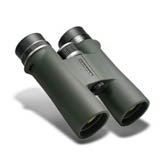 Be forewarned . . . I just realized that this blog entry has become a billboard. But for good reason that you'll appreciate, especially if you are in the market for new quality binoculars.
Be forewarned . . . I just realized that this blog entry has become a billboard. But for good reason that you'll appreciate, especially if you are in the market for new quality binoculars.
Back in February I discovered the binoculars I hoped to own one day. I found them at the Eagle Optics display at the San Diego Bird Festival. I'd been dreaming about getting a really fine pair of binoculars but knew they would cost in the neighborhood of $1,500 or maybe even higher. Prior to attending the Bird Festival I'd shopped a little in my local area. I casually looked at a pair or two of the high-end optics and then immediately lowered my sights to a more affordable price. Not that they wouldn't have been nice to have ... they were just too expensive. Although I found a pair of lower-priced binoculars that would have worked, they weren't much different than what I'd been using. My dream was to improve on that -- although I don't have much to complain about with my old standbys.
Anyway, at the Bird Festival all the great optics were there to compare. And compare, I did. I discovered what really good optics are all about and the clarity and brightness that comes with superior glass and coatings. The advice of "don't sneak a peak through someone's top-of-the-line optics if you intend to be satisfied with your moderately-priced ones" was good . . . but a little late for me 'cause I'd already looked.
I found some $1,600 binoculars that were impressive, to say the least. If not in quality, for sure in dollars. Just kidding ... the quality was superb. Then I did a reality-check. Should I spend so much money ... no, I shouldn't. So I kept wandering around the optics display area and finally got to Eagle Optics. This company represents many (probably all) manufacturers and they've been in business since 1986. It is a company that knows what it's doing -- and they have a great reputation. So I decided to do some comparisons at their booth. And what did I find ... an absolutely great pair of binoculars that gave me the same quality I'd seen in the most expensive glasses I'd just been looking at. But they cost about $700 less! Whew! After taking these binoculars outside to view an Osprey nest at the top of a condemned boat, it didn't take me long to decide these were my dream binoculars. But the price was still on the high side so I needed to think about it. Fortunately, Eagle Optics does most of its business online. So no rush, I could order them when I was ready.
Well, the unexpected happened and I found myself making the decision to buy the binoculars sooner than I'd dreamed. It was a dreary, rainy day when they arrived this week. Wouldn't you know it. But I didn't let the rain stop me -- I set the diopter and took them outside. I wasn't testing their water-proofness (although I could have), but rather I just wanted to see how bright the image was. Now picture this . . . it was dark and gloomy with a very light drizzle at the time. I focused on our backyard birch trees and I could see the raindrops hanging from the branches. But here is the thing -- the raindrops were so bright they glistened like little stars and the whole scene was crisp and beautiful. I couldn't believe the image could be so bright when the sky was so dark. I wish I had taken a picture of it through the binoculars. I guess I could have done that ... like a mini-disigscope. What kind of binoculars did I get? I thought you'd never ask. Here are all the details in case your curiosity is getting the better of you.
Manufacturer - Vortex
Name - Stokes DLS 8 x 42 (10x42 also available). Yep, the Stokes couldn't wait to put their name on these babies. Evidently, they are also their binoculars of choice for their own birding.
Field of View - 383 feet at 1,000 yards
Eye Relief - 18 mm
Close Focus - 4 feet 5 inches. Can you believe it? I can lay in my hammock and have a front row seat watching the hummingbirds at the feeder just above my head. This close focus is also superb for butterfly watching.
Dimenions (HxW) 5.5 x 4.875 inches
Weatherproofing - Waterproof/Nitrogen Purged
Vortex VIP Warranty - If my binoculars should ever require service, no matter what the case, Votex will repair or replace the binoculars absolutely FREE. The warranty is even transferable, but it doesn't cover theft, loss or deliberate damage. But that's only fair. It's a great warranty but one that will never by transferred by me. I'm not letting go of these binocs.
Eagle Optics 30-day Guarantee - I have the right to return the binoculars to Eagle Optics within 30 days if I'm not satisfied, less return shipping charges No chance of that! ... but nice to know.
At the risk of sounding like an Eagle Optics employee, here's more: These binoculars have 64-layer premium mirror-coated BaK-4 deviation prisms with the latest generation of phase corrected prism coatings.
The Total Optical Performance System gives you:
Pure silver coated, phase-corrected prisms for the highest image contrast and resolution.Precisely engineered and enhanced optical tube design to eliminate annoying glare and image ghosting. (Roof prism design . . . pictured above)
High-density prism glass and lens elements for exceptional image brightness and sharpness. That sure is the truth!
Twilight optimized multi-layered lens element coatings for optimal low light performance. Guess this why my raindrop image was so bright and clear. Highly polished and precision shaped lens elements and prisms for true flat field performance and minimal spherical distortion.
XHR (eXtremely High Resolution) fully multi-layered coatings to deliver excellence in resolution and color fidelity. No doubt about that.
Precisely designed optical system for particularly clear and precise focusing from extremely close range to infinity.
Smooth focus with just the touch of a finger -- fast enough to stay with warblers hopping as close as 4.5 feet, or swallows flying erratically out to infinity.
Optimum near-to-far focus travel reacts swiftly in 1.25 revolutions.
Soft, contoured eyecups can be locked in place when fully extended.
Multiple eye relief settings are accessed by twisting down the eyecups for wide, unobstructed views with eyeglasses.
Superb depth of field let you find and follow wildlife more easily.
Click-stop diopter control is conveniently located adjacent to the right eyepiece for precise adjustments for differences in your eyes.
Okay, okay so I got carried away with all the details. Forgive me. I couldn't help myself -- I'm so excited about these binoculars. In fact, before buying them I decided to do some research to figure out what all the techno-speak stuff was about. I learned enough to really appreciate what these DLS Binoculars offer. Now that I understand what it takes to have a good pair of birding binoculars I put together an easy primer so anyone can understand the basics. This is a primer that beginning birders might find especially useful. The primer will be available soon at Birding Binoculars so check back if you're interested.
The bottom line is that choosinbg binoculars is a very personal decision. With so many binoculars and manufacturers to choose from I'm grateful to have found the perfect ones for me. My suggestion is if you're in the market for quality binoculars check them out -- they may be the absolute end-all, perfect ones for you, too.
I never realized the impact blogging would have on me. I never realized I'd have so much fun writing about the going-ons in my life. I suppose that's because I've always been kind of a private person. But what do you know ... here I am writing about my life almost daily. And surprise of surprises ... I enjoy it. Who would have thought.
But the best part of blogging is the people I've met. It's been amazing. I have new friends in Australia, Singapore and most recently Costa Rica. And those exotic places don't lessen the impact of those I've met here in the U.S. And then there are the blogs these people and others write. There is a growing list of My Favorite Blogs over on there on the right. There are certainly many talented folks out there in cyberland and they bring insight and humor to my life daily. Computers are wonderful inventions.
My newest acquaintance from Costa Rica authors A Broad In Costa Rica . . . the play on words in the title is just an inkling of humor you'll discover as she writes about her family's adventures as new residents in Costa Rica. Don't miss it.
I also discovered a service on her blog offered by FeedBlitz that allows people to subscribe. What this means is that you'll get an email when there is a new post. Of course, XML syndication is available, too ... as it is on my blog (just over there to the right). But people seem to get confused over how that works and it's said that about 80% of potential subscribers avoid XML because they just don't understand it. Now I really don't know if anyone feels the need or desire to subscribe to my blog, but I thought I'd offer a subscription opportunity, too. Afterall, it's nice to think that I might contribute something about my interest in birds that others might find worth revisiting. So in case that's true and you'd like to get an email notice of new postings then just add your name to the subscribe block (over in the right column) and press Subscribe Me. Your information will be as confidential as you choose it to be. And be assured this is not something that will generate spam or any privacy issues.
I found a good way to make new friends is to leave comments on blogs . . . or on websites. So if you have a comment, something to share, or maybe a request just let me know. I'll do my best to respond.
Today is going to be full of non-birding activities until tonight. Then I get to go the second meeting of the Beginning Birding Class I wrote about yesterday. I'm ready and enthusiastically looking forward to what the next birding pro will share. Besides the birds themselves, it's the people you meet in the birding world that can be just as fascinating. More on the birding class tomorrow.
 When I received an email promoting a beginning birding class sponsored by the Buena Vista Audubon Nature Center I just couldn't resist signing up. Although I've been birding for awhile I was curious to see what an official birding class had to offer. Besides the BV Nature Center is close enough that I can get my nighttime pet bird chores done and still make it on time. So last Wednesday off I went.
When I received an email promoting a beginning birding class sponsored by the Buena Vista Audubon Nature Center I just couldn't resist signing up. Although I've been birding for awhile I was curious to see what an official birding class had to offer. Besides the BV Nature Center is close enough that I can get my nighttime pet bird chores done and still make it on time. So last Wednesday off I went.
First of all, the Nature Center is a pretty cool place. It is set adjacent to Buena Vista Lagoon in Oceanside (northern San Diego County). The Center is primarily devoted to educating children and they do a great job.
There are many bird specimens which really help to appreciate and remember the field marks of those species. Fortunately, the Nature Center has a volunteer who does taxidermy and she offers her services for free. I was very happy to hear that all the specimens were found in a deceased condition within Buena Vista Lagoon. I'm a real bleeding heart and I don't think I could bear hearing that the birds were captured for taxidermy purposes. I'm afraid if that were the case my experience at Buena Vista would have been ruined. I can't help it ... I just don't deal well with animal death. I know I need to be realistic and I am to a point. But the bottom line is I am a real bleeding heart and I struggle dealing with it.
Anyway, the first class was informal because it was combined with a general meeting of the BV Audubon Society. There was a guest speaker from another Nature Center in the San Diego area. She was a very experienced birder who has been birding for about 35 years. While her talk was informal it was interesting and focused on the mystery and magic of birds. A slide presentation of field marks accompanied her talk.
Then last Saturday we had a field trip to the Lagoon area of the Nature Center -- Buena Vista Lagoon, to be exact. The field trip included an informal talk on "Introduction to Birding" focusing on the birds of fresh water wetlands. The field trip began at 8:30 a.m. That meant rushing around to get morning bird chores done before I could leave. I was organized and out the door in time to get to the field trip on time, but in my rush forgot my binoculars. Did I say I was organized? Evidently, not well enough. Sheesh! I thought only I could pull a stunt like that, but found out later that people who've been birding forever have been known to do the same thing. But I really felt foolish and had to rely on the trip leader's scope to see my birds.
Here is the list of what I saw: Pied-billed Grebe, Western Grebe, White Pelican, Great Blue Heron, Mallard, Cinnamon Teal, Northern Shoveler, Gadwall, Ruddy Duck, Osprey, Red-tailed Hawk, Common Moorhen, American Coot, Black-necked Stilt, Ring-billed Gull, Anna's Hummingbird, Cliff Swallow (and their nests under a bridge), American Crow and Marsh Wren. Not bad for standing in one spot for a couple of hours.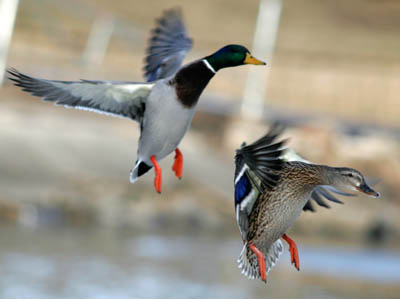 We'll have four more class meetings along with field trips. Each field trip will be to a habitat that provides an opportunity to use skills and see the types of birds covered in the previous class meeting. The last field trip will be to participate in the Buena Vista Audubon Society's Birdathon--America's Birdiest City Contest. The Beginning Birder's Class will form a team to participate in this event to test their new skills. Should be fun and a great way to finish the class.
We'll have four more class meetings along with field trips. Each field trip will be to a habitat that provides an opportunity to use skills and see the types of birds covered in the previous class meeting. The last field trip will be to participate in the Buena Vista Audubon Society's Birdathon--America's Birdiest City Contest. The Beginning Birder's Class will form a team to participate in this event to test their new skills. Should be fun and a great way to finish the class.
Then on April 15th I'm going to attend a Birding By Ear class also sponsored by BVAS. I'm really looking forward to it because identifying birds by their song will be new to me. I just haven't put much effort toward learning those skills. More on that later.
I should have my new binoculars for the next field trip. I can't wait to get them ... they will be my first real high quality optics. I'm getting an Eagle Optics Bino System Harness strap, too. With that gadget I can hang my binocs around my neck in comfort and without them swinging around. They tell me that these straps are the way to go. So I'll hang my new binocs around my neck before I leave the house. I don't think I could deal with forgetting them twice.
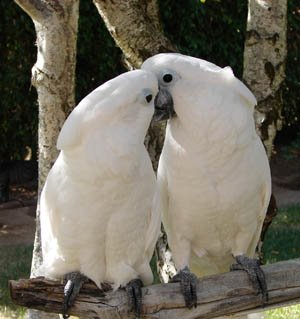 Last night I went to bed wondering what today would bring. Maybe it would be an energetic day and I'd get some work done. I need that sense of accomplishment because I have too many things to do and not enough time. Or I could weaken and ignore the projects by taking a trip up to Lake Henshaw to see the Bald Eagles. Last night I was really leaning that direction. It's much more fun to go look for wild birds and enjoy nature than put my nose to the grindstone. But as it turned out I didn't do either. Bummer!
Last night I went to bed wondering what today would bring. Maybe it would be an energetic day and I'd get some work done. I need that sense of accomplishment because I have too many things to do and not enough time. Or I could weaken and ignore the projects by taking a trip up to Lake Henshaw to see the Bald Eagles. Last night I was really leaning that direction. It's much more fun to go look for wild birds and enjoy nature than put my nose to the grindstone. But as it turned out I didn't do either. Bummer!
Yesterday I got up early to attend the field trip. So by the end of a very busy day I should have been pretty tired. I was. But after going to bed I found I couldn't go to sleep. At 3 a.m. I was still wondering when I would fall asleep. Not good. So when it was time to get up I dragged myself out of bed and felt wasted. And I never bounced back.
So now the day is almost over and I have little to show for it. OK, it's Sunday and is supposed to be a day of rest. So, I rested. I'll leave it at that. In a few minutes I'll be heading to the bird room to do nighttime chores. It is a part of my daily routine and I've been doing it for 22 years. The only time I get a break is when I go on vacation and that has been a rare occurrence lately.
I guess if my avian "kids" where human they would be out on their own by now. But since they are not . . . I'll be doing these chores daily until I can no longer physically do them. That will be a long time from now, if I'm lucky. Lucky? Yep! Even though I get real weary of doing the routine I'll keep doing it forever because sharing my life with my birds is so meaningful to me it's become my lifestyle. It's how I think of myself . . . I'm a parrot person.
Maybe its partly habit -- it's hard to break any habit even it involves sacrifice. But it is mostly the intense connection I feel to these amazing birds. I wish I could find the words to really describe how meaningful that connection is. What it really means to me. I guess I've always been much more animal/nature-oriented that most people. Maybe that is the reason I seem obsessive about my avian companions. But I know it is really because of who they are. Unless you live with abundantly-nurtured, hand-reared parrots (or a dearly loved pet of some other persuasion) you might not be able to understand even if I were to find the right words to describe this connection I'm talking about.
Since I can't find the words to really explain how I feel I just leave it like this. Because of who they are, my avian friends deserve my devotion and protection. And I'll make sure they get it. So I'll hang in there for them, especially since they've put up with me and a domesticated lifestyle all these years.
 I intended to chat about a birding class I'm taking and the birds we saw on our first field trip today. But I'll Leave that for tomorrow.
I intended to chat about a birding class I'm taking and the birds we saw on our first field trip today. But I'll Leave that for tomorrow.
It's more interesting to give a brief update on the Bald Eagles and their nest at Lake Henshaw which I've written about during the past couple of weeks. While I was on my field trip a local birder here in San Diego took the opportunity to visit the Bald Eagles to observe today's happenings. And, wow, did he have good luck. He watched one of the adult eagles feeding a chick. Yes, there is now proof that a chick has hatched. The nestling was visable all during this feeding and appeared to take all the food. There was only one eaglet, as far as he could see. It seems reasonable that if there were two in the nest they both would have been seen. While one adult eagle fed the young the other was out flying over Lake Henshaw evidently in search of another tasty meal. However, the eagle didn't have any success and was harrassed by one of three Red-tailed Hawks that live in the area. The eagle returned to the nest but then left shortly and was again harrassed by the hawk. Then the eagle attending the nest flew out over the lake with the same result.
The birder also noted three Turkey Vultures drifting in and out over the nest, sometimes simultaneously with the hawks. By the time the birder left the eagle originally tending the nest had settled down over the nestling.
So it is ... a morning in the life of Mr., Mrs. and Junior Bald Eagles. Now here is my dilemma. Do I take a trip to Lake Henshaw myself tomorrow to see all this drama for myself? It sure is what I want to do. But I may not have the opportunity. I'll have to wait and see what is on tomorrow's agenda.
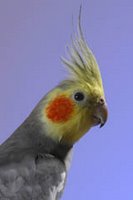 I've been asked when it all started ... when I did I get interested in birds. That got me thinking. I'd had to go way back ... back to my early childhood. I'm not sure what age I was when our family got Budgies. We had two and I was in grade school. The budgies were untame so they weren't companions.
I've been asked when it all started ... when I did I get interested in birds. That got me thinking. I'd had to go way back ... back to my early childhood. I'm not sure what age I was when our family got Budgies. We had two and I was in grade school. The budgies were untame so they weren't companions.
Some years passed. When I was a young teenager my Dad brought home two Cockatiels -- Junior and Pancho. Junior was handfed and was a love. Pancho was probably handfed also, but hadn't been handled enough as he got older and was a little nippy. So Junior became my pal. He'd eat breakfast with me every morning before school and later in the day we'd have some playtime. The only time he got into trouble was at breakfast one morning. He hopped down to the table and proceeded to jump into my bowl of cheerios. Being an animal-loving family we didn't consider that anything but a funny event -- we all got a big laugh out of it. But Junior did need a bit of cleaning up and my cereal had to be replaced.
Sometime later my Dad decided to build an aviary in our backyard and then he brought home some more cockatiels. I think we had ten. Dad is gone now so I can't ask him about his intentions for the cockatiels. And I can't remember because sometime later my parents separated. Understandably, the separation was an extremely traumatic time for me and may be the reason for my failed memory. Perhaps Dad meant to breed the cockatiels. I don't know. He had built an area within the aviary which housed them at night and contained their food and water. But I don't remember seeing any nestboxes.
It was Junior, my cockatiel, that connected me to birds. He was the most wonderful little creature and I loved him more than anything.
I was a very shy kid and it was hard for me to stand up in front of my school class and give reports and things like that. I do remember vividly that one of my classroom assignments was to give a report on any subject of my choosing. Along with the talk, I had to use the chalkboard to explain my subject matter. Whew! I was scared to death. What got me through it was talking about my Cockatiels. I drew a picture of our aviary for the chalkboard part of it. I guess the A+ I got on my report should have been an indicator of the future serious interest I would have in birds.
My next birds were budgies that I kept in my apartment when I went to college. They weren't tame but were nice companions, nevertheless.
It wasn't until I was in my early forties that birds really became a big part of my life. My connection with Junior always remained with me. One day -- many years after sharing my life with him -- I happened by a bird store where a Moluccan Cockatoo was displayed. I was instantly captivated. I'd never seen anything so beautiful. That vision stayed with me for several more years. Then my circumstances changed and I found myself able to buy a Moluccan. But that's another story.
Now it is twenty two years later and Fagan, the Moluccan, is still with me plus 13 other birds. My interest in birds has grown from being Mom to my avian family to a die-hard birdwatcher, creator of a website Birdwatchin'.com devoted to that interest, publishing a birdwatching newsletter -- David's Wild Bird News! . . . and this blog. I guess you could say that birds have become a way of life. And I couldn't be happier!
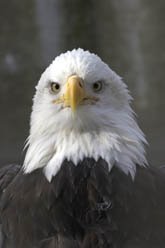 It is frustrating to not have the time to go to Lake Henshaw right now to see the Bald Eagle activity. So I'm grateful to receive posts from the SD Birding Group. One of the birders posted the following message which is definitely worth passing on to anyone interested in Eagles.
It is frustrating to not have the time to go to Lake Henshaw right now to see the Bald Eagle activity. So I'm grateful to receive posts from the SD Birding Group. One of the birders posted the following message which is definitely worth passing on to anyone interested in Eagles.
Here is the message: "This afternoon we watched the Bald Eagles nesting at Lake Henshaw. One was on the nest and you could see the top of the head moving. This eagle was visible most of time. The other bird was across the lake perched in tree. It changed trees while we watched. At about 5 pm it took off and was not seen for a short time. It then came flying across the lake to the nest, passing over us. It carried food for the eagle with nest duties, probably a small mammal. That bird stretched then ate while the other sat to the side of the nest. They then changed places, with the eagle that hunted taking up the nest and the nesting bird flying off. We found as we were leaving that it had returned and was perched in a dead tree not far from the nest tree."
What a great experience that any bird lover would be thankful to have. I hope my next trip to Lake Henshaw will be as a productive an experience.
Also of note in her message was the following: "Also the lake is host to a large number of White Pelicans. I estimate at least 50. Three weeks ago there might have been 3 times that number." Yes, I would agree. We were up there about that time and there were a very large number of White Pelicans. They were a bit far off, but with the scope could be identified.
Viewing Lake Henshaw is done from a road elevated above the lake. On my last visit to there were a very large number of all kinds of water birds. Most were circling in the air and it was interesting to look down on them as they flew.
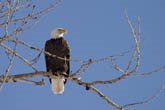 Good news! One of the local birders here in San Diego made it up to Lake Henshaw to check on the bald eagles and their nest. The parent birds were seen and everything looked a-ok. So, I guess my worries were unfounded. But, as I said, since I wasn't sure if the unexpected snow would cause any harm, I could only hope the eagles would be fine. It's great to have confirmation that they are.
Good news! One of the local birders here in San Diego made it up to Lake Henshaw to check on the bald eagles and their nest. The parent birds were seen and everything looked a-ok. So, I guess my worries were unfounded. But, as I said, since I wasn't sure if the unexpected snow would cause any harm, I could only hope the eagles would be fine. It's great to have confirmation that they are.
Since this active eagle nest is within driving distance I must find some extra time to learn more about their nature. Being able to observe them is a great incentive to learn more. I hope to visit the nest soon to watch the the young eagles as they progress toward fledging. It would really be great if this eagle family is content to stay in our area. What an opportunity it would be to continually visit Lake Henshaw and be able to sight them occasionally. They actually have picked a good spot to raise a family. Lake Henshaw is large and has plenty of fish. Enough to attract many species of birds. Sighting the eagles would definitely be frosting on the cake.
 We've had such a nice winter .... weather-wize. That is, until the past couple of weeks. Actually, I was wishing for rain as we need it here in Southern California. While the temperature dropped into the 50's we didn't get any wet weather until the past week.
We've had such a nice winter .... weather-wize. That is, until the past couple of weeks. Actually, I was wishing for rain as we need it here in Southern California. While the temperature dropped into the 50's we didn't get any wet weather until the past week.
In the coastal regions the rain has been rather mild, but enough to get some moisture in the ground. In the higher elevations the latest storm coming down from Alaska brought much lower temperatures and snow to the mountains surrounding San Diego. In fact, the snow was as low as 2,000-3,500 feet depending on which day we are talking about. And boy, did they get snow ... enough to close the roads to Julian and Mt. Palomar. Now, that is pretty incredible to me ... since these places are less than a hour away from where I live, which is near the coast.
Thinking about the amount of snow that would cause road to close gave me concern about the nesting Bald Eagles I wrote a blog about on February 25th. The most recent sighting of these Eagles came from a birder that belongs to the San Diego Birding Group. The birder saw one of the Eagles at the nest and the bird looked like it was regurgitating food into the nest. To me, that can only mean one thing ... one or more chicks had hatched. This was within the last week or so.
So my concern is over the rain, snow and cold weather and how it would affect newly hatched chicks. I'm not an Eagle expert, by any means. So my concern maybe unnecessary ... but I still can't help but worry. Of course, Bald Eagles live in cold climates like Alaska and the Pacific Northwest. From what I can tell from my field guide their year-round range in these areas is along the coast, but it is still very cold there in the winter. So they must be well adapted to frigid weather. Our area is part of their winter range. I wonder if these Eagles are year-round residents or migrated here to raise their young. Lots to wonder about.
I hope the unexpectedly cold weather and snow isn't a hazard. I'm looking for an update on the Eagles via someone in the SD Bird Group. But I don't suppose anyone can get up there until the roads are open again. That should be soon. When the report comes I hope it is good news ... that the Eagle family is doing well. I'll go up to take a look as soon as I can. Right now it's not possible with a close relative in the hospital recovering from open heart surgery. Just no extra time for birding right now.
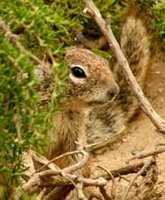 We don't have tree squirrels in the coastal regions of Southern California. But ground squirrels are abundant in the more rural areas. I've lived in my current home almost 4 years but it was only this past fall that a ground squirrel discovered one of my bird feeders. I guess I asked for it since it was a platform-style feeder designed to sit on the ground. It was set out for the many ground feeding birds that visit ... everything from White-crowned Sparrows, Quail and California Towhees to the neighborhood peacocks.
We don't have tree squirrels in the coastal regions of Southern California. But ground squirrels are abundant in the more rural areas. I've lived in my current home almost 4 years but it was only this past fall that a ground squirrel discovered one of my bird feeders. I guess I asked for it since it was a platform-style feeder designed to sit on the ground. It was set out for the many ground feeding birds that visit ... everything from White-crowned Sparrows, Quail and California Towhees to the neighborhood peacocks.
Surprisingly, all went well for several months because our local squirrel population has decreased somewhat. In fact, recently I've only noticed one squirrel. I'd know if there were more around because they tend to stay in groups when they are looking for food. So I'm assuming there is just one. Anyway, he finally found the feeder and the seed disappeared very quickly. Although this was a bit disturbing I didn't mind feeding him ... too much, anyway. Then he got enterprising, as squirrels do. He found one of the large hanging feeders and since it was located near a fence he made quick work of that food, too.
Okay, I have a choice. I can let him clean out my feeders everyday or two. But that will really make a dent in my budget and I'll have an extremely over-weight squirrel. Or I can give him his own food, like dried corn on the cob. That is the first thing I've decided to do. This may deter him somewhat, but I don't expect a miracle. So what else to do.
Recently, I found out about a squirrel deterrent that shouldn't cause him harm, but is supposed to strongly discourage him. Here is the idea:
Puree hot peppers and make a spray. I supposed that means straining the pureed hot peppers and then adding some water. Then add a few drops of Ivory liquid soap to the spray. Spray it on plants to keep squirrels away. I'm going a step farther. I'll spray my wooden feeders in addition to the small potted tree the squirrel uses to get on the fence. I've decided to try Habaneros peppers since they are very hot and easily found in the grocery store.
There are a couple of other ideas I learned about, which I'll do in addition to the pepper spray. One idea makes sense for me because I have a cat.
Evidently, if you place a very small amount of used cat litter around budding plants it will deter squirrels. Since my little "friend" isn't bothering my plants I thought I might try this idea at the base of the potted tree he climbs. Evidently, the cat smell makes a squirrel believe that the cat is nearby which sends him on his way to a safer location.
I understand that sprinkling blood meal around the borders of your garden is a good deterrant, too. I suppose that placing the meal around my ground feeder might add to the effectiveness of my squirrel-deterrent plan.
It will be interesting to see if these solutions work. I hope so, because I don't want to harm the squirrel (actually I really like watching him). I just don't want him devouring all the bird food. Maybe he should learn some table manners ... gluttany isn't attractive. Then he could dine with the rest of the critters.
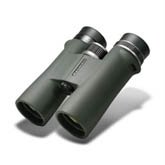 A couple of weeks ago the San Diego Audubon Society sponsored their annual Birding Festival. It was a 4-day event. I was only able to go for 2 days to attend a couple of classes on digiscoping. The speakers were excellent and I learned a lot. I was disappointed though because I missed all of the birding field trips and keynote speaker, Pete Dunn. That was due to the events filling up fast. Those misses were very unfortunate and I'll be sure to make early reservations for the Birding Festival next year.
A couple of weeks ago the San Diego Audubon Society sponsored their annual Birding Festival. It was a 4-day event. I was only able to go for 2 days to attend a couple of classes on digiscoping. The speakers were excellent and I learned a lot. I was disappointed though because I missed all of the birding field trips and keynote speaker, Pete Dunn. That was due to the events filling up fast. Those misses were very unfortunate and I'll be sure to make early reservations for the Birding Festival next year.
On Saturday there were lots of vendors and organizations providing information. With all the binoculars, scopes, etc. on display I discovered and confirmed what my next pair of binoculars will be. Selecting binoculars is a highly individual choice. Where I thought the real high-end equipment like Swarvoski, Zeiss, etc. would be just what I'd probably want, I discovered an Eagle Optics binocular that suited me just fine and is equal in visual quality to the more expensive designs. In fact, I like these binoculars better ... they are really perfect for me. My excitement over the decision to get them is in high-gear. Liking these binocs better than the real expensive ones surprised me because it always seems that to get what I really want means paying a higher price. So while my budget will be hit fairly hard at $879, it seems reasonable as compared to the mid-$1,500-plus range.
I'm still using my first pair of binocs ... Audubons. When I bought them they seemed adequate enough and for some things, they still are. I guess real die-hard birders would consider them priced on the low end of the scale. Like I said they still are ok ... but after looking through my new choice ... Stokes Birding Series DLS 8x42's ... with their much better optical quality I know I need these new ones!
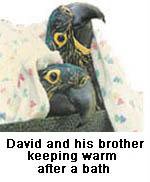 David Jeffrey, my Hyacinth Macaw got his middle name in an odd way. It all began because the lady who hand-fed David chose, what she considered to be, very sweet boy names for the two Hyacinth babies she was raising. It's easy to understand her desire because handfed Hyacinths are such incredibly sweet baby birds.
David Jeffrey, my Hyacinth Macaw got his middle name in an odd way. It all began because the lady who hand-fed David chose, what she considered to be, very sweet boy names for the two Hyacinth babies she was raising. It's easy to understand her desire because handfed Hyacinths are such incredibly sweet baby birds.
When I bought David I kept his name because I've always preferred naming most of my pets with human names. This is especially true for my parrots. Parrots have such human characteristics it seems almost insulting to give them some "cutsey" pet-type name. But that's just my personal feeling, of course. There are many parrots in the world with great names that aren't normally used for people.
David has a brother and they were raised together until being separated to go to their new homes. When I arrived to pick up David I discovered a house full of people there to celebrate David going to his new home. One of the guests was confused over which bird was David and which one was Jeffrey. So everytime she spoke to one of the Hyacinths' she would call him David-Jeffrey.
Then we discovered that Jeffrey's new "parents" wanted to change his name to something different. So the name Jeffrey was abandoned. That made the lady who raised Jeffrey kind of sad because she thought the name was so appropriate. Since the party-goer had used the name David-Jeffrey it stuck for me. So we officially added Jeffrey as David's middle name.
I have an African Grey with a middle name, too. But that's another story.
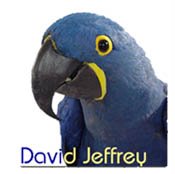 This month I celebrated my first anniversary of making the decision to build a website about birds ... mostly about backyard birdwatching. Since I have a nice family of exotic birds I couldn't help but include a little about them, too. It's been quite a journey and is directly responsible for my having this blog. I began this Internet project knowing absolutely nothing about building a website or any of the satellite "stuff" it led to.
This month I celebrated my first anniversary of making the decision to build a website about birds ... mostly about backyard birdwatching. Since I have a nice family of exotic birds I couldn't help but include a little about them, too. It's been quite a journey and is directly responsible for my having this blog. I began this Internet project knowing absolutely nothing about building a website or any of the satellite "stuff" it led to.
If not for a friend of mine in Canada I never would taken on such an endeavor. She gave me the encouragement. My thanks to her is sincerely given. Since my passion is birds it has been very satisfying to create Birdwatchin'.com. But I never could have even remotely considered doing so without a very affordable program used by thousands of people around the world. For anyone who has considered creating a website to promote an interest or earn an income I can highly recommend checking it out. It truly over-delivers. There are a lot of examples of what people have accomplished with this tool. If you want to see what a real Internet novice (and I do mean beginner) has been able to do using this program ... then take a look at Birdwatchin.com. I'm still find it incredible that I actually did it. It amazes me!
Anyway, the website has led to other activities such as this blog. And it is also the reason I'm launching a newsletter called David's Wild Bird News! The first issue is due to come out in the next few days. Who is David? ... actually, his full name is David Jeffrey (there's a reason for the double name ... I'll explain tomorrow). David is my Hyacinth Macaw. He "volunteered" to be the host of the newsletter. I'm just his assistant. Anyway, if you love bird watching check out Birdwatchin.com and subscribe to the newsletter ... it's free!
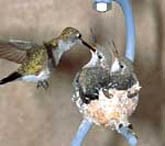 I've been planning my backyard to encourage my wild bird visitors raise a family. I'm really looking forward to observing wild birds behavior as it pertains to rearing babies. I've had the amazing personal experience of raising four Umbrella Cockatoos some years ago. Raising those babies was a real eye-opener because I learned first hand what labor-intensive work it is to get a baby bird to the fledging point. And that's just the beginning of the needs of a young bird until it is ready to survive by itself. Knowing first-hand about the work it takes makes my desire to help the wild birds stronger because they also have the challenge of survival.
I've been planning my backyard to encourage my wild bird visitors raise a family. I'm really looking forward to observing wild birds behavior as it pertains to rearing babies. I've had the amazing personal experience of raising four Umbrella Cockatoos some years ago. Raising those babies was a real eye-opener because I learned first hand what labor-intensive work it is to get a baby bird to the fledging point. And that's just the beginning of the needs of a young bird until it is ready to survive by itself. Knowing first-hand about the work it takes makes my desire to help the wild birds stronger because they also have the challenge of survival.
I don't remember any other experience that was as rewarding as watching my baby Umbrellas grow up. Only another person who has participated in such an event will really understand what I mean about reward. So with those memories well entrenched I've been trying to decide what kinds of bird house/nestboxes (how many and where) I should put up. While doing my research I came across a nesting platform made especially for hummingbirds. I didn't know such a thing existed. Anyway, when I saw it I knew I had to have it. Only one time in my life have I seen a nest of hummingbirds. There were 2 babies in the nest. They were so tiny -- frankly, I was transfixed as I stood there watching them. But the sad thing was ... a wind storm came the very next day and destroyed the nest. I could find nothing left. It broke my heart and I've never forgotten it.
So I'm thinking ... hmmm! perhaps this hummingbird nest platform will be just the ticket to accomplish two goals:
- The platform may provide a sturdy base for the hummingbird to build her nest and help prevent the kind of tragedy I encountered before.
- If I choose the place for mommy hummingbird to build her nest ... then I'll know where to find the baby hummingbirds. Being so small, hummingbird nests are hard to find ... but I'll know where to look.
The success of providing the nest will depend on where I put it. The hummingbird is going to have to like it's location ... that's for sure. So I'll do some more research about what type of environment and location is the best. Then this new adventure will begin.
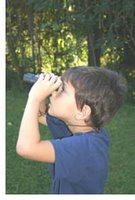 Got any little birders in your family that are budding and ready to bloom? Here's an idea to help them enjoy watching birds.
Got any little birders in your family that are budding and ready to bloom? Here's an idea to help them enjoy watching birds.
With spring just around the corner we're setting up bird house/nestboxes now so they'll be ready for the arrival of our avian visitors. It's pretty amazing to watch the progress of birds raising their families. It's even more enjoyable to watch little kids excitement over this kind of event. We want to rig a way to watch new bird babies on the inside of the nestbox. It's the ideal way to monitor their development and health ... not mention a terrific educational opportunity for kids. There's been a good amount of discussion around here about how to accomplish such a project easily. We've been making a list of equipment, accessories, etc. The project seemed somewhat daunting. Then I discovered that you can buy a nestbox all ready to record this amazing springtime event. Yippee! Check it out ... maybe offering such a nestbox would be perfect for your backyard.
Speaking of kids ... why not give them a fun project that will help the birds with their nesting activities. Here's an idea ... offer nesting material for the birds (see what's needed for the project below). No kids? Or maybe you just don't have the time for such a project. Then just get a kit all ready to offer. There are even nesting material replacements available for it, too.
Need some help choosing the right nestbox, this Birdwatchin.com guide will help you. Also check out the 10 most important features every nestbox should have.
Here's the Nesting Material Project:
Have the kids prepare a selection of materials from the following items (they've all been used by birds to build their nests). Then lightly pack the materials in a suet feeder and hang near your bird house. Use one or more of these material-filled feeders(*) depending the number of bird houses you are offering.
Yarn or string (cut the pieces about 4 to 6 inches)
Hair (human or animal hair -- horse hair is great)
Sheep's wool
Feathers
Shredded Paper
Dry Grass (use your clippings after mowing the lawn ... be sure they are chemical free)
Dead twigs and leaves
Straw
Plant fluff or down from Cottonwoods or Cattails
Cotton batting or other material used for stuffing
Moss
Bark Strips
Pine needles
Cloth (cut in stips 1/2" wide by 6" long)
(*) If you don't have a suet feeder to offer the nesting material just lay some of the natural items
on your plants and hedges, hang in trees, etc. It will help the birds, but won't be as much fun as watching the birds take the materials from a suet feeder that you've placed nearby.
Providing nesting opportunities for birds is the best way to celebrate the coming of spring.
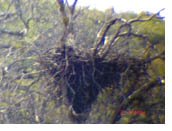 We took a drive to Lake Henshaw today for our first digiscoping experiment. After confirmation that Bald Eagles had an active nest there, I was eager to use my newly rigged-up digiscope to see if I could get a photograph of them.
We took a drive to Lake Henshaw today for our first digiscoping experiment. After confirmation that Bald Eagles had an active nest there, I was eager to use my newly rigged-up digiscope to see if I could get a photograph of them.
Due to an appointment I couldn't get to the lake until about 12:30 p.m. knowing that I couldn't stay long. Upon arrival there was no eagle in view. So, we decided to wait to see if either the hen or her mate would make an appearance.
The nest is huge -- so big that when an adult eagle is incubating it is not visable from below. The tree were the nest is located is upslope from the road where we must park and view. It is also about 300 yards from where we could set up the digiscope. So it is impossible to see if an eagle is in the nest.
After about 40 minutes of waiting to see an eagle I felt compelled to pack up and try again another day as I needed to be home by 3:00 p.m.
Then two ravens came soaring overhead ... one had nesting material in it's beak. That intrigued me so I followed it with my binocs. Both birds put on an interesting aerial show and I was captivated. Then I saw the bird drop the nesting material and a few moments later land on the ground. It picked up something ... I couldn't see what it was. It flew towards the lake shore and landed and proceeded to eat whatever it had picked up. Some poor hapless creature, no doubt. After a few minutes the raven's activity attracted 5 turkey vultures looking for a meal to steal. Since I hadn't had any luck with the eagles I decided to photograph the drama on the ground. Unfortunately, my photographic attempt failed. With that disappointment I decided it was time to go home.
Just my luck ... with the scope removed from sighting the eagles nest I turned just in time to see one of the bald eagles return to the nest. Wouldn't you know it! I had a great opportunity to get a pretty exciting burst of photographs (or even a movie) ... if I'd just been a little more patient. My first lesson in learning to photograph wild birds ... be patient and make sure the camera is set for the most optimal shot. Okay, so now you know how much of a novice I really am.
Although my first attempt met with failure, it was still an exciting hour of bird watching. You can be sure that I'll be back up at Lake Henshaw to try again. Oh, that eagles nest photo in the upper left corner is the one I photographed today ... sans the eagles., of course. Yep, I know it is pretty poor ... but didn't I just mention I'm a novice. So much to learn -- so little time!
 One special experience this past spring was during an extremely hot period. We had a broken sprinkler and after it was fixed the system was turned on to make sure everything was working okay. Shortly after the sprinklers came on an adult male Cooper's Hawk swooped down into the spray and had himself a good soak ... flapping wings as he jumped and danced in the spray. I ran for my camera and warily made my way back as close as I could to the hawk. Surprisingly when I got back with the camera another hawk (that I assume was his mate since a pair of Cooper's had been nesting nearby) had joined him and they were both having a great time in the cool water. I was transfixed watching the amazing display and by the time I got ready to take a picture I discovered the camera batteries were dead. So I quietly retreated to the house for another camera and loaded new batteries to be safe. By the time I returned to my hiding place the active bathing was over and the female had flown to a nearby palm tree. I tried to get a good shot of the male who, by now, was just standing in the spray. I snapped a couple of shots and then he flew away to join his mate. Before I turned around to leave another hawk flew down to get his share of the cool water. Again I took pictures, but they were disappointing, too (as you can see by the photo above). However, it does show an immature Cooper's Hawk. My guess is that this youngster was this year's offspring of the pair bathing earlier.
One special experience this past spring was during an extremely hot period. We had a broken sprinkler and after it was fixed the system was turned on to make sure everything was working okay. Shortly after the sprinklers came on an adult male Cooper's Hawk swooped down into the spray and had himself a good soak ... flapping wings as he jumped and danced in the spray. I ran for my camera and warily made my way back as close as I could to the hawk. Surprisingly when I got back with the camera another hawk (that I assume was his mate since a pair of Cooper's had been nesting nearby) had joined him and they were both having a great time in the cool water. I was transfixed watching the amazing display and by the time I got ready to take a picture I discovered the camera batteries were dead. So I quietly retreated to the house for another camera and loaded new batteries to be safe. By the time I returned to my hiding place the active bathing was over and the female had flown to a nearby palm tree. I tried to get a good shot of the male who, by now, was just standing in the spray. I snapped a couple of shots and then he flew away to join his mate. Before I turned around to leave another hawk flew down to get his share of the cool water. Again I took pictures, but they were disappointing, too (as you can see by the photo above). However, it does show an immature Cooper's Hawk. My guess is that this youngster was this year's offspring of the pair bathing earlier.






















